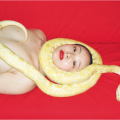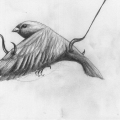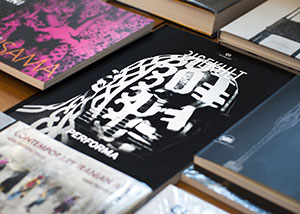The visual artist Eleonora Roaro often gets inspired by the history of art and creates metaphors about existence, as she previously did with her work “Loop” about the archeology of cinema. In this installation project she revisits devices such as zoetropes, praxinoscopes and magic lanterns, which were fundamental for the development of cinematographic language and techniques. These instruments were based on loops, sequences of images which repeated a complete action. Although the loop might be conceived as a technical limitation, on the contrary it becomes a narrative engine, as Lev Manovich has stated in his book “The Language of New Media” (2001). Indeed, each photographic sequence tells a story, which in its persistent and obsessive repetition is a metaphor for human limitations. This cyclic time follows the natural dimension of things, abandoning the theleologic Christian world view. Through a self-portrait within an aseptic and minimal space the author often refers to literary figures, history of art and mythological archetypes, in order to achieve a transformation into “otherness”. Her new project is about a flower which was used in dutch still lives from the XVII century as a metaphor for vanitas and transience: the tulip. The video installation “Tulipomania” refers to a period in the Dutch Golden Age during which contract prices for bulbs of tulips reached extraordinarily high levels and then suddenly collapsed. It consists of 5 videos (06’02’’ each) which run simultaneously on 5 monitors, forming a circle. The soundtrack, made by Massimiliano Viel and performed by Icarus Ensemble, is a remake of “Marche pour la cérémonie des Turcs“ by J. B. Lully which is a parody of Luigi XIV court. Each video shows a tulip undergoing a process of transformation which modifies its initial condition. A cellophane like a veil of Maya prevents the tulip from being seen clearly and suddenly gets on fire. Anyhow, the resulting tulip is indistinguishable from the original one: even when we get rid of illusions we cannot see things as they are. Another tulip arises from black water, a symbol of illness, and soon become black itself. The alteration of a natural process creates a sick beauty that it’s destined to die, as it happend to the Semper Augustus, the tulip which caused the craziest eccess of tulipomania in the XVII century, whose stripes were owed to a virus. All these mutations evoke the conceit of impermanence (mujo in Japanese), conveying the feeling that everything is changeable and ephemeral. This way the tulip shifts from being the symbol of economical speculation to become the universal metaphor for the process of value attribution and illusion as a form of survival. In the 5th video, for instance, a diamond rain soon turns into black sand: we cannot enrich forever, the bubble is destined to blow up, the dream of capitalism has to die. It refers to Damien Hirst’s diamonds skull “For the love of God” which cost 13 million pounds and was sold for 50 million pounds and might be considered the most evident case of economical speculation in art. So this flower is an emblem for the lack of proportion between the real thing and its value, which invests every aspect of our lives, not only the economical one. It reminds us, like in dutch vanitas from the XVII century, that everything is destined to change, perish and die. Nature – cruel and wild – shows its indifference towards humankind and has in itself a truth, which was important for the development of ancient myths and symbologies.
Eleonora Roaro: Tulipomania and Other Stories
LINK: www.eleonoraroaro.com
VIDEOTulipomania from Eleonora Roaro on Vimeo. COMMENTSRELATED POST |
|
|
|
|









































